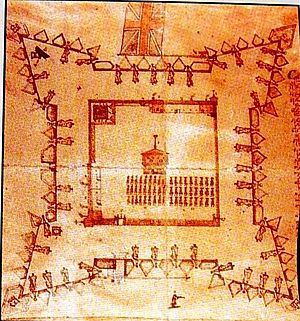Fort William Augustus facts for kids
Fort William Augustus was a British fort built on Grassy Island, near Canso, Nova Scotia. It was also known as Grassy Island Fort or Fort Phillips. This fort was built around 1720, just before a conflict known as Father Rale's War.
The idea for the fort came after some earlier troubles. In 1718, there was an event called "The Squirrel Affair" and a British attack on Fort St. Louis. After these events, a man named Cyprian Southack suggested to Governor Richard Philipps that a fort should be built. The fort was named after Prince William, Duke of Cumberland, who was King George's son.
Building the Fort
Building Fort William Augustus was not easy. On August 7, 1720, while the fort was still being built, about 60 to 75 Mi'kmaq people joined French fishermen from Petit de Grats to attack it. During this attack, three men were killed, four were hurt, and the fort was badly damaged. The New Englanders, who were building the fort, captured 21 people and sent them to Annapolis Royal. This attack was important because it involved the Mi'kmaq and helped lead to Father Rale's War.
Later in 1720, the New Englanders finished building a permanent fort. They named it Fort Phillips, after Governor Richard Philipps. Building a permanent fort like this went against old agreements between the Mi'kmaq people and the fishermen. This disagreement was a big reason why Father Rale's War began.
In 1721, the governor of Massachusetts started to act as if they owned the fishing areas around Canso. They sent a British warship, HMS Seahorse, to patrol the waters near Nova Scotia. With British soldiers now in the area, the Mi'kmaq were less likely to attack for a while. The HMS Seahorse was later replaced by a New England ship called William Augustus, commanded by Cyprian Southack.
Father Rale's War Attacks
During Father Rale's War, the fort and village faced more attacks. On July 23, 1723, the Mi'kmaq raided the village again. They killed three men, a woman, and a child. In the same year, the New Englanders built a strong, twelve-gun blockhouse to protect the village and its important fishing industry.
In 1725, another attack happened. About sixty Abenaki and Mi'kmaq warriors attacked Canso. They destroyed two houses and killed six people.
King George's War
Years later, in the 1730s, Edward How helped rebuild parts of the fort and added a blockhouse. However, during King George's War in 1744, the French and Mi'kmaq attacked Canso again in what was known as the Raid on Canso. They destroyed Fort William Augustus. After this, the area was used as a starting point for the Siege of Louisbourg (1745). A new blockhouse was built nearby, which was named Fort Prince William (Nova Scotia).
Grassy Island Fort Today
Today, Grassy Island Fort is recognized as a National Historic Site of Canada. It received this special status in 1962. If you visit Grassy Island, you can still see the remains of the original fort from 1720, the fort built in 1723–24, and the blockhouse from 1735. It's a place where you can learn about an important part of Canadian history.


